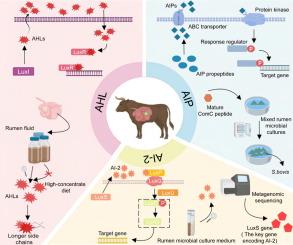Regulatory mechanisms of quorum sensing in microbial communities and their potential applications in ruminant livestock production
IF 13
1区 综合性期刊
Q1 MULTIDISCIPLINARY SCIENCES
引用次数: 0
Abstract
Background
Quorum sensing (QS) is a cell-to-cell communication system that enables microbial communities to dynamically regulate their metabolism and physiological activities according to the surrounding cell density. The rumen’s diverse microbial ecosystem represents a classic example of host-microbiome symbiosis. Despite significant progress in understanding the composition and function of ruminal microbial communities, the underlying communication mechanisms in the rumen ecosystem remain largely enigmatic. Gaining insight into these regulatory mechanisms is crucial for developing knowledge-based strategies to improve animal productivity, health, and sustainability in ruminant livestock production.Aim of review
This review aims to provide an overview of microbial QS communication systems mediated by diverse signaling molecules, including bacterial intraspecies and interspecies QS, fungal QS, and archaeal QS. We conducted a structured review by searching multiple scientific databases, synthesizing data from relevant studies, and critically evaluating the roles of QS systems in microbial communities. This approach ensures a comprehensive analysis of the current understanding of QS mechanisms and their implications for ruminant livestock. Specifically, we elucidate the identification and potential mechanisms of the QS system facilitated by three prevalent signaling molecules (N-acyl homoserine lactones, autoinducing peptides, and autoinducer 2) in ruminants. Recent advances in understanding the effects of QS on microbial fermentation, immune function, biofilm formation, and virulence factor production are summarized in detail, providing a scientific basis for applying QS in ruminant livestock production.Key scientific concepts of review
The rumen harbors various QS signaling molecules that modulate microbial community dynamics, impacting composition, structure, and function. The versatility of QS allows it to regulate ruminal fermentation and inhibit pathogen growth, thereby improving productivity and reducing disease risk in ruminants. This review synthesizes recent advances in QS mechanisms, crucial for disease prevention, combating antibiotic resistance, and promoting sustainable livestock production. Future research should investigate QS pathways and networks in the rumen microbiome through in vivo experiments and multi-omics analyses to gain a deeper understanding of microbial community regulation.

微生物群体感应的调节机制及其在反刍家畜生产中的潜在应用
群体感应(quorum sensing, QS)是一种细胞间的通信系统,它使微生物群落能够根据周围细胞密度动态调节其代谢和生理活动。瘤胃多样化的微生物生态系统是宿主-微生物共生的一个经典例子。尽管在了解瘤胃微生物群落的组成和功能方面取得了重大进展,但瘤胃生态系统中潜在的通讯机制在很大程度上仍然是谜。深入了解这些监管机制对于制定以知识为基础的战略以提高反刍牲畜生产中的动物生产力、健康和可持续性至关重要。本文综述了多种信号分子介导的微生物QS通讯系统的研究进展,包括细菌种内和种间的QS、真菌的QS和古细菌的QS。我们通过检索多个科学数据库,综合相关研究数据,并批判性地评估QS系统在微生物群落中的作用,进行了结构化的综述。这种方法确保了对QS机制的当前理解及其对反刍家畜的影响的全面分析。具体来说,我们阐明了反刍动物中三种常见的信号分子(n -酰基高丝氨酸内酯、自诱导肽和自诱导物2)促进QS系统的鉴定和潜在机制。本文详细综述了QS对微生物发酵、免疫功能、生物膜形成和毒力因子产生影响的最新研究进展,为QS在反刍家畜生产中的应用提供科学依据。瘤胃中含有多种QS信号分子,这些信号分子调节微生物群落动态,影响其组成、结构和功能。QS的多功能性使其能够调节瘤胃发酵,抑制病原体生长,从而提高反刍动物的生产力,降低疾病风险。本文综述了QS机制的最新进展,这些机制对疾病预防、对抗抗生素耐药性和促进可持续畜牧生产至关重要。未来的研究应通过体内实验和多组学分析来研究瘤胃微生物组中的QS通路和网络,以进一步了解微生物群落的调控。
本文章由计算机程序翻译,如有差异,请以英文原文为准。
求助全文
约1分钟内获得全文
求助全文
来源期刊

Journal of Advanced Research
Multidisciplinary-Multidisciplinary
CiteScore
21.60
自引率
0.90%
发文量
280
审稿时长
12 weeks
期刊介绍:
Journal of Advanced Research (J. Adv. Res.) is an applied/natural sciences, peer-reviewed journal that focuses on interdisciplinary research. The journal aims to contribute to applied research and knowledge worldwide through the publication of original and high-quality research articles in the fields of Medicine, Pharmaceutical Sciences, Dentistry, Physical Therapy, Veterinary Medicine, and Basic and Biological Sciences.
The following abstracting and indexing services cover the Journal of Advanced Research: PubMed/Medline, Essential Science Indicators, Web of Science, Scopus, PubMed Central, PubMed, Science Citation Index Expanded, Directory of Open Access Journals (DOAJ), and INSPEC.
 求助内容:
求助内容: 应助结果提醒方式:
应助结果提醒方式:


